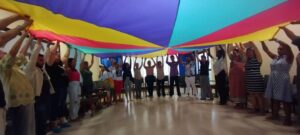
Then you changed my despair into a dance—
you stripped me of my death shroud
and clothed me with joy.
That’s why my heart sings to you,
that’s why I can’t keep silent—
YHWH, you are my God,
and I will thank you forever!
-Psalm 30:11-12 The Inclusive Bible
“Todavía nos dura el gozo que experimentamos unidas en Holguín. Desde que llegué de Holguín he estado intencionando la planificación de lo nuevo de EXIT./ The joy that we experienced together in Holguín still lasts. Since I arrived back from Holguín, I have been planning a new EXIT group.” -a graduate of the first ever Expressive Arts in Transition certificate program in Cuba
 In early April, I was thrilled to be a part of the final celebration of a nearly year-long facilitator training process with 8 certified graduates from the Expressive Arts in Transition (EXIT) process in Holguín, Cuba. Having completed 45 hours of training, 6 hours of supervision, leadership of a 10 session EXIT group in their community, a written theory-based paper and a live presentation, each graduate received a certificate, a small personal art kit and lots of hugs. We were honored to have the founder of the Expressive Arts in Transition process, Dr. Melinda Ashley Meyer with us. Dr. Meyer is a renowned researcher at the Norwegian Centre for Violence and Traumatic Stress Studies (NKVTS) and the Director and Co-founder of the Norwegian Institute for Expressive Art and Communication (NIKUT). She recently received the King’s Medal of Merit, one of the highest honors granted to citizens of Norway. Her important work continues to change lives around the world. She joined me, Shabrae Jackson and Lyd Pensado as the training team. Shabrae is the founder of Collective Tapestries and UMBRAL (arts-based NGOs) and hails from West Palm Beach, FL and Lyd is the co-founder of UMBRAL from Mexico City. Both work to accompany organizations, churches, and groups providing arts-based psychosocial trauma support among migrants at the Tijuana and Guatemala-
In early April, I was thrilled to be a part of the final celebration of a nearly year-long facilitator training process with 8 certified graduates from the Expressive Arts in Transition (EXIT) process in Holguín, Cuba. Having completed 45 hours of training, 6 hours of supervision, leadership of a 10 session EXIT group in their community, a written theory-based paper and a live presentation, each graduate received a certificate, a small personal art kit and lots of hugs. We were honored to have the founder of the Expressive Arts in Transition process, Dr. Melinda Ashley Meyer with us. Dr. Meyer is a renowned researcher at the Norwegian Centre for Violence and Traumatic Stress Studies (NKVTS) and the Director and Co-founder of the Norwegian Institute for Expressive Art and Communication (NIKUT). She recently received the King’s Medal of Merit, one of the highest honors granted to citizens of Norway. Her important work continues to change lives around the world. She joined me, Shabrae Jackson and Lyd Pensado as the training team. Shabrae is the founder of Collective Tapestries and UMBRAL (arts-based NGOs) and hails from West Palm Beach, FL and Lyd is the co-founder of UMBRAL from Mexico City. Both work to accompany organizations, churches, and groups providing arts-based psychosocial trauma support among migrants at the Tijuana and Guatemala-
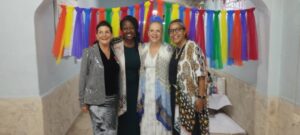 Mexico borders. With tons of experience and wisdom, both have been friends, mentors and teammates in Expressive Arts facilitation for trauma accompaniment and healing work with me over the last decade. I am blessed beyond measure to have this dream team working alongside me in my role as a Global Consultant for Training with the Restorative Arts through International Ministries.
Mexico borders. With tons of experience and wisdom, both have been friends, mentors and teammates in Expressive Arts facilitation for trauma accompaniment and healing work with me over the last decade. I am blessed beyond measure to have this dream team working alongside me in my role as a Global Consultant for Training with the Restorative Arts through International Ministries.
Our graduates led 10 sessions of Expressive Arts in Transition in various communities across Cuba: in Santiago, Holguín, Las Tunas and Bautas. Over 70 people, ranging in age from 6 years old to almost 80 years young, formed creative circles in churches, mental hospitals, community centers and backyard gardens. Putting their learning into practice, these trained facilitators supported exhausted mothers caring for children with special needs, lonely senior adults grieving from the impact of increased migration of their children and grandchildren, and vulnerable children suffering the consequences of economic collapse and food scarcity. To give you a glimpse of the dire economic situation at this point, the average monthly salary for a university trained professional is around 6000 Cuban pesos which translates to roughly $12, that’s less than 50 cents a day. The context in which these dedicated leaders are serving is complicated and difficult. Access to this training process would be impossible without God’s grace and the scholarships made possible by generous donors and supporters. In the middle of these struggles, curiosity was cultivated, colors were crafted into safe landscapes, songs were sung, and joyful dance had the last laugh. We often ask ourselves, “Can we play in the pain?” I’d say these graduates prove that we can.
In response to the question: What do you hope to receive as you continue your learning and training in EXIT and in the expressive arts? One participant responded:
“Continuar trabajando con ustedes, tenerlas cerca nos hace mucho bien. Son luz ante tanta oscuridad./To continue working with you, having you close to us does us a lot of good. You are light in the face of so much darkness.”
One of the key components of the Expressive Arts in Transition model is the keeping of the circle. Groups are gathered, sit and remain in the circle during the 90 minute weekly group sessions. The circle holds the group together. It is a safe container, a sacred space to offer welcome and belonging. In traumatized populations, physical, emotional, spiritual and relational safety has been breached and regaining a sense of being “safe enough” is our first priority. As one of the participants shared in her presentation, our bodies have a tangible reminder of the circle of life and connection. Our belly button is a circle that speaks to our first nurturing relationship in the womb. We explored and played in the circle with gestures and sounds that were witnessed and repeated by the group, and by holding onto the edges of a parachute and feeling the tension, tug, transitions and togetherness of the group. The Spanish word for parachute is paracaida which literally means “for falls”. The parachute play reminded us that the purpose of the circle is to be there to support and rescue those who fall and that when we or others leave, there is impact and the group must adapt and adjust and also make room for return when folks come back.
Another key component of the Expressive Arts in Transition model is coming home to the body. In order to survive the unspeakable and senselessness of trauma, our minds often exile us from our own bodies.Trauma gets stuck or frozen in the body. It shows up in stiff joints, headaches, stomach issues and back pain. Through movement and grounding exercises, we work to loosen up the tight places and tend to the tender spots where our body is trying to get our attention. We explore how we are walking in the world and play with trying new ways to walk and to meet ourselves and each other again. We notice and pay attention to what helps, practicing what brings life back to ourselves and others.
I’ve mentioned the practice of aesthetic response in past updates. As I pondered the image of the dance from Psalm 30 and remembered what is moving in me from my time with my Expressive Arts in Transition colleagues in Cuba, these words came:
Meet me in the circle
That surrounds both head and heart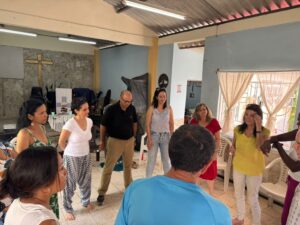
Where tension and trust learn to dance
There we’ll find each other
This place of grace where hope takes shape
Where movement flows
Through beats and lines,
Rhythm and rhyme
Meet me in the circle
Where tension finds trust
Moving in and out
To and fro
Above, below
Within, without
And everywhere in-between
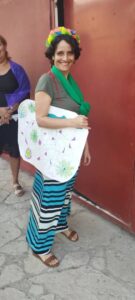
This space, not fixed, yet safe enough
To play with pulls and pushes
Leans and lunges
Crouching and crushing
A slight, a tug, a tightening
A loosening and letting go
Hold on, be held
Feel the shift
Breathe
Meet me in the circle
All of us
Sojourners, returners, exiles, and stay putters
Searching and stuck
With fears and tears
Griefs and gifts
Broken and whole-ly
Looking for our place to fit
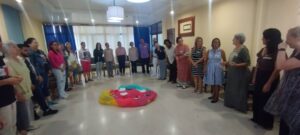
Come home to the circle
We belong
M Baits
April 2024
As this note is getting a bit too lengthy, please stay tuned for another note from me and Gary coming to you within the week. I can’t tell you enough how appreciative I am for you and for the opportunities your partnership provides me to witness God’s amazing work in the world.
Thank you so much,
Mylinda